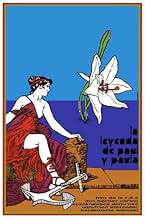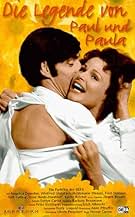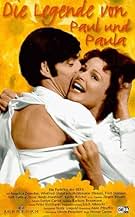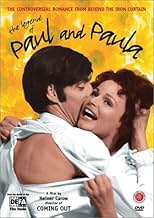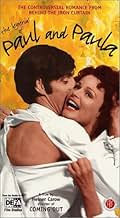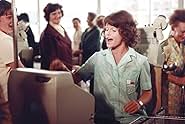NOTE IMDb
6,8/10
1,3 k
MA NOTE
Paul et Paula ont eu de mauvaises expériences avec l'amour: Paul a perdu toute affection pour sa femme, et Paula mène une vie difficile en élevant seule deux enfants. Ils se rencontrent et s... Tout lirePaul et Paula ont eu de mauvaises expériences avec l'amour: Paul a perdu toute affection pour sa femme, et Paula mène une vie difficile en élevant seule deux enfants. Ils se rencontrent et se découvrent une forte passion l'un pour l'autre.Paul et Paula ont eu de mauvaises expériences avec l'amour: Paul a perdu toute affection pour sa femme, et Paula mène une vie difficile en élevant seule deux enfants. Ils se rencontrent et se découvrent une forte passion l'un pour l'autre.
- Réalisation
- Scénario
- Casting principal
Frank-Otto Schenk
- Kollege Schmidt
- (as Frank Schenk)
Avis à la une
"Die Legende von Paul und Paula" (1973), co-written and directed by Heiner Carow, is a famous film in Germany. The story seems tame enough now--a young woman is dissatisfied with her life and takes active steps to improve it.
Angelica Domröse plays Paula, a single mother who has a dead-end job and no social life. Winfried Glatzeder portrays Paul, who is unhappily married and is drawn to the free-spirited Paula. (Glatzeder has been called East Germany's Jean-Paul Belmondo. He didn't look much like Belmondo, and wouldn't have struck me as leading man material. However, I don't know enough about East German cinema to be aware of his competition.)
I've been told that the reason for this film's popularity in East Germany was because it contained subtle criticism of the regime, as well as depicting some PG-13 sex. I know East German films were subject to strict censorship, and, as in any similar regime, directors inserted criticisms in ways that were necessarily very indirect and symbolic.
The problem is that this movie only works if you can think of how you would have viewed it in East Berlin in 1973. I don't believe it's strong enough to succeed on its own merits in 2006.
Angelica Domröse plays Paula, a single mother who has a dead-end job and no social life. Winfried Glatzeder portrays Paul, who is unhappily married and is drawn to the free-spirited Paula. (Glatzeder has been called East Germany's Jean-Paul Belmondo. He didn't look much like Belmondo, and wouldn't have struck me as leading man material. However, I don't know enough about East German cinema to be aware of his competition.)
I've been told that the reason for this film's popularity in East Germany was because it contained subtle criticism of the regime, as well as depicting some PG-13 sex. I know East German films were subject to strict censorship, and, as in any similar regime, directors inserted criticisms in ways that were necessarily very indirect and symbolic.
The problem is that this movie only works if you can think of how you would have viewed it in East Berlin in 1973. I don't believe it's strong enough to succeed on its own merits in 2006.
Heiner Carow's "Die Legende von Paul und Paula" is the first GDR film I've watched which centered on a woman and her development as an individual, which was new to DEFA within that period of time. "Die Legende..." is different from other films made before it since the story was about a woman who seeks for self-fulfillment and follows her heart in spite of the rigidity of societal norms.
In this film, Paula is the epitome of what women were mostly portrayed as in the 1970s: emotional rather than rational.
Paula is a quirk of a character. She wears her heart on her sleeve and cares not one bit what happens as long as she is happy. She seems a bit over the edge at some points in the film, though. As if she were about to break down at a moment's notice. Her character is intense and Angelica Dumrose fully consummates the part.
In this film, Paula is the epitome of what women were mostly portrayed as in the 1970s: emotional rather than rational.
Paula is a quirk of a character. She wears her heart on her sleeve and cares not one bit what happens as long as she is happy. She seems a bit over the edge at some points in the film, though. As if she were about to break down at a moment's notice. Her character is intense and Angelica Dumrose fully consummates the part.
This is a film from the time when you only saw Trabant (GDR-made) and Volga (Soviet-made) cars on the streets. It is a sad love story, set among the ruins of old German houses and the new blocks of socialism. In the soundtrack we hear some songs by the band from DDR Die Puhdys, unfortunately not the best from their repertoire, actually some very bad, they having some really excellent ones, being the most valuable rock band in communist Germany. For a film made in that period, when in countries like GDR, Poland, Romania, Bulgaria, Czechoslovakia, Hungary, Albania the films were nothing but communist propaganda, this film is a
real exception, being very libertine, something inexplicable how it got away of the fierce censorship of the regime. In Yugoslavia the situation was different, they were much freer. And, there were bolder films in Hungary, Poland, Romania, but they were banned soon after release or scenes were cut. Angelica Domröse plays a role full of courage, totally unconventional for the politics behind the iron curtain. Scenes of sex and alcohol consumption could not be seen in those films of communist countries where everyone had to appear happy, without problems, living a wonderful life, in a perfect society, where children were brought by storks, not being the fruit of a sexual act between a man and a woman.
This film is a fascinating artifact to watch, and I use my language carefully there. This is perhaps not a film with as much current meaning and significance as other pieces of German cinema, but when watched as an artifact of how it might have felt to live in East Germany in the 70s (not to suggest that Paul and Paula themselves are necessary the model), it is a fascinating and interesting watch. Of course, within this, I do not seek to reduce it simply to a piece of history, it is art, entertaining and beautifully done, but I do think one needs to watch from the perspective of an East German in the 70s.
What does this entail? It entails watching not for a simple critique of East Germany and socialism. It entails watching not for a love story. It entails watching not to fulfil some preconceived notion of what is right and what is wrong. Instead, one must seek to go beyond these simple conclusions. I'm not the one to say what this film means, and that is precisely my point. When this film was released East Germany was far behind its Western counterpart in terms of economic development. Socialism was not achieving what it desired. It's easy in that light to jump to conclusions right away about what the film means. Instead of doing that, ask why Erich Honecker, leader of East Germany, would have personally allowed this film to be shown? Ask why this film was (and still is to many) beloved by East Germans. My point is, this film is more than one thing, equally critical as it is optimistic, equally a love story as it is a Shakespearian tragedy, and equally compelling as it is confusing.
Give it a watch, you may not like it (I only gave it a 7), but it is incredibly rich.
What does this entail? It entails watching not for a simple critique of East Germany and socialism. It entails watching not for a love story. It entails watching not to fulfil some preconceived notion of what is right and what is wrong. Instead, one must seek to go beyond these simple conclusions. I'm not the one to say what this film means, and that is precisely my point. When this film was released East Germany was far behind its Western counterpart in terms of economic development. Socialism was not achieving what it desired. It's easy in that light to jump to conclusions right away about what the film means. Instead of doing that, ask why Erich Honecker, leader of East Germany, would have personally allowed this film to be shown? Ask why this film was (and still is to many) beloved by East Germans. My point is, this film is more than one thing, equally critical as it is optimistic, equally a love story as it is a Shakespearian tragedy, and equally compelling as it is confusing.
Give it a watch, you may not like it (I only gave it a 7), but it is incredibly rich.
This picture, which has been shown in East Germany for only a week until political censors understood its impact on the people, is a very realistic East German view of life in post war East Berlin. It's mainly about the romance of Paul, a privileged but unhappy secret service agent, and Paula, an underprivileged and single girl with children. Since it is one of the very few movies which portraits honest details of real life in East Berlin at that time, it now serves as a reminder of emotions and feelings for a lot of East Germans. Despite the heavy use of symbolism (pretty old houses are blown away for the construction of uniform socialist buildings) it still doesn't draw a too pessimistic picture and leaves space for dreams and hope. I really love this movie, and I would recommend it to anyone who wants to catch a glimpse idea of how life was at that time in a socialistic system. The film is available with English subtitles which gives foreigners the chance to understand it, too.
Le saviez-vous
- AnecdotesFemale DEFA-director Ingrid Reschke made preparations for the film, but her life was tragically cut short in a car accident, and Heiner Carow took over the project. He dedicated the film to her memory.
- ConnexionsEdited into Der nackte Osten - Erotik zwischen oben und unten (1994)
- Bandes originalesGeh zu Ihr
Music by Peter Gotthardt
Lyrics by Ulrich Plenzdorf & Peter Gotthardt
Performed by Puhdys
VEB Deutsche Schallplatten Berlin AMIGA
Meilleurs choix
Connectez-vous pour évaluer et suivre la liste de favoris afin de recevoir des recommandations personnalisées
- How long is The Legend of Paul and Paula?Alimenté par Alexa
Détails
- Date de sortie
- Pays d’origine
- Langue
- Aussi connu sous le nom de
- The Legend of Paul and Paula
- Lieux de tournage
- Sociétés de production
- Voir plus de crédits d'entreprise sur IMDbPro
Contribuer à cette page
Suggérer une modification ou ajouter du contenu manquant

